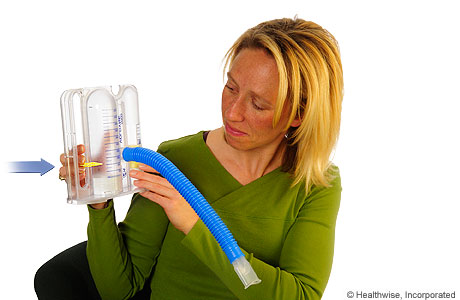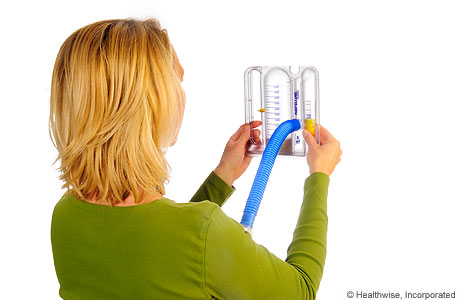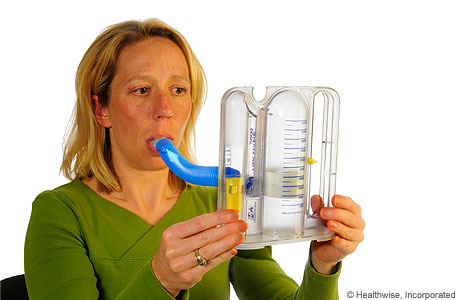top of the pageactionset
breathing exercises: using a manual incentive spirometer
overview
an incentive spirometer is a hand-held device that exercises your lungs and measures how much air you can breathe in. it tells you and your doctor how well your lungs are working.
the spirometer can help you practice taking deep breaths. deep breaths can help open your airways and prevent fluid or mucus from building up in your lungs, and make it easier for you to breathe.
using the device can help prevent serious lung infections like pneumonia, improve your breathing after you've had pneumonia or surgery, and keep your airways open and lungs active if you can't get out of bed.
how do you use an incentive spirometer?
when you use an incentive spirometer, you'll breathe in air through a tube that is connected to a large air column containing a piston or ball. as you breathe in, the piston or ball inside the column moves up. the height of the piston or ball shows how much air you breathed in. you may feel light-headed when you breathe in deeply for this exercise. if you feel dizzy or like you're going to pass out, stop the exercise and rest.
each time you do this exercise, keep track of your progress by writing down how high the piston or ball moves up the column. this will help you and your doctor know how well your lungs are working.
move the slider.

slide 1 of 6
slide 1 of 6, move the slider. ,
move the slider on the outside of the large column to the level that you want to reach or that your doctor recommended.
hold the spirometer in front of you.

slide 2 of 6
slide 2 of 6, hold the spirometer in front of you. ,
sit or stand up straight, and hold the spirometer in front of you. be sure to keep it level.
breathe out.

slide 3 of 6
slide 3 of 6, breathe out.,
to start, breathe out normally.
then close your lips tightly around the mouthpiece. make sure that you don't block the mouthpiece with your tongue.
breathe in.

slide 4 of 6
slide 4 of 6, breathe in. ,
take a slow, deep breath. breathe in as deeply as you can. as you breathe in, the piston or ball inside the large column will move up. try to move the piston or ball as high up as you can or to the level your doctor recommended.
when you can't breathe in anymore, hold your breath for 2 to 5 seconds.
breathe out.

slide 5 of 6
slide 5 of 6, breathe out. ,
relax, remove the mouthpiece, and then breathe out normally.
repeat steps 1 through 5 as many times as your doctor tells you to. then go to the step 6.
cough.

slide 6 of 6
slide 6 of 6, cough. ,
after you've taken the recommended number of breaths, try to cough a few times. this will help loosen any mucus that has built up in your lungs. it will make it easier for you to breathe.
if you just had surgery on your belly or chest, hold a pillow over your incision when you cough. this will support your belly or chest and reduce your pain.
repeat these steps as many times a day as your doctor tells you to.
credits
current as of: august 6, 2023
author: healthwise staff
clinical review board
all healthwise education is reviewed by a team that includes physicians, nurses, advanced practitioners, registered dieticians, and other healthcare professionals.
current as of: august 6, 2023
author: healthwise staff
clinical review board
all healthwise education is reviewed by a team that includes physicians, nurses, advanced practitioners, registered dieticians, and other healthcare professionals.